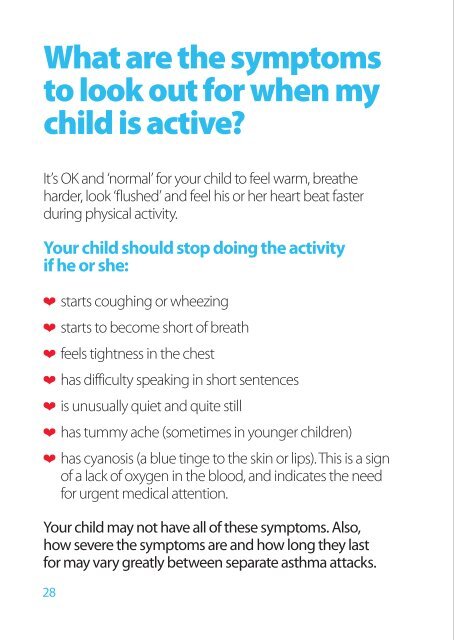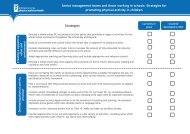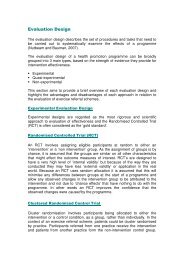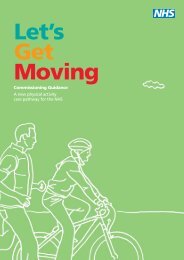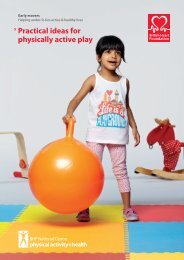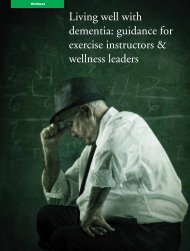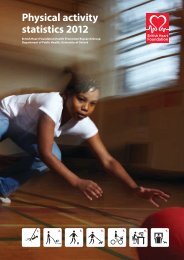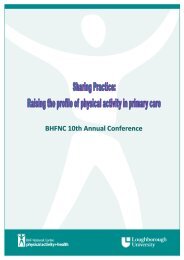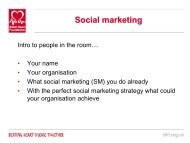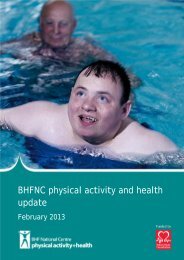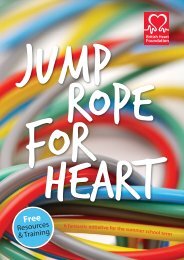Physical activity – What if my child has asthma? - BHF National ...
Physical activity – What if my child has asthma? - BHF National ...
Physical activity – What if my child has asthma? - BHF National ...
Create successful ePaper yourself
Turn your PDF publications into a flip-book with our unique Google optimized e-Paper software.
<strong>What</strong> are the symptomsto look out for when <strong>my</strong><strong>child</strong> is active?It’s OK and ‘normal’ for your <strong>child</strong> to feel warm, breatheharder, look ‘flushed’ and feel his or her heart beat fasterduring physical <strong>activity</strong>.Your <strong>child</strong> should stop doing the <strong>activity</strong><strong>if</strong> he or she:❤❤starts coughing or wheezing❤❤starts to become short of breath❤❤feels tightness in the chest❤❤<strong>has</strong> d<strong>if</strong>ficulty speaking in short sentences❤❤is unusually quiet and quite still❤❤<strong>has</strong> tum<strong>my</strong> ache (sometimes in younger <strong>child</strong>ren)❤❤<strong>has</strong> cyanosis (a blue tinge to the skin or lips). This is a signof a lack of oxygen in the blood, and indicates the needfor urgent medical attention.Your <strong>child</strong> may not have all of these symptoms. Also,how severe the symptoms are and how long they lastfor may vary greatly between separate <strong>asthma</strong> attacks.<strong>What</strong> to doIf you notice any of the signs or symptoms opposite:❤❤Get your <strong>child</strong> to stop and rest immediately.❤❤Never push your <strong>child</strong> to continue their <strong>activity</strong>. Asthmasymptoms will often get worse once <strong>activity</strong> is stopped,so insisting that your <strong>child</strong> keeps going until they areforced to rest can be dangerous.❤❤Give your <strong>child</strong> one or two puffs of their reliever inhaler(usually blue) immediately, preferably through a spacer.❤❤Sit your <strong>child</strong> up and slightly forward. Don’t lie themdown or hug them.❤❤Encourage them to take slow, steady breaths.❤❤Loosen tight clothing.❤❤Stay with them and reassure them.❤❤If there is no immediate improvement, continue to makesure your <strong>child</strong> takes two puffs of their reliever inhalerevery two minutes, taking up to 10 puffs.❤❤If your <strong>child</strong>’s symptoms don’t improve after 10 puffs, or<strong>if</strong> you are worried at any time, call 999 for an ambulance.❤❤If an ambulance does not arrive within 15 minutes andyour <strong>child</strong> is not improving, give further doses of theirreliever inhaler. Make sure your <strong>child</strong> takes two puffs oftheir reliever every two minutes, taking up to 10 puffs.Asthma 28 29


